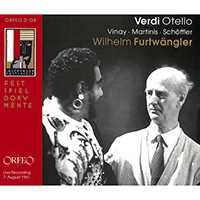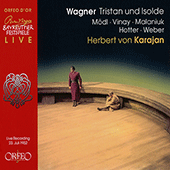Ramon Vinay
After Vinay’s Chilean mother died when he was only five years old, his French father, a veteran of military action on the French side in World War I, sent for his three sons to join him in France. Between 1920 and 1926 Ramón lived in Digne and studied electrical engineering. When he was fifteen however his father sent him to Mexico City for further training and here he studied singing with José Pierson, making his operatic stage debut in 1931 as a baritone singing Alphonse / La Favorite. He joined a travelling opera company in 1934 for which he sang di Luna / Il trovatore, followed by Amonasro / Aida, Scarpia / Tosca and the title role in Rigoletto.
Unable to subsist on the small fees he earned from singing, Vinay founded a successful box-manufacturing company, while not completely abandoning singing. Indeed he was heard by the Broadway producer Lee Shubert, who cast him in the revue Streets of Paris which ran in New York from 1939 to 1940. Vinay then returned to Mexico where he continued to sing baritone roles; but on discovering that he could sing into the tenor range he retrained as a tenor (with René Maison in New York, according to certain sources). He made his debut as a tenor in 1943 in Mexico City singing Don José / Carmen, followed by the title role of Otello in 1944.
During 1945 Vinay first appeared in New York, with the New York City Opera as Don José. This was sufficiently successful for him to be invited to sing other roles with the City Opera, including Samson / Samson et Dalila, Cavaradossi / Tosca and des Grieux / Manon Lescaut; and to appear with the Metropolitan Opera, initially as Don José once again, in early 1946. His success was sealed in 1947 when Toscanini selected him to sing Otello in his scheduled national NBC broadcast and subsequent RCA recording of this opera, commenting: ‘He is a complete artist, magnificent and unsurpassed in roles which require power and violence. At the present time no other artist comes near Vinay’s interpretation of Otello.’
The cachet of this engagement and of Toscanini’s high praise ensured that Vinay was immediately launched into an international career at the highest level. He opened the 1947–1948 season of La Scala, Milan as Otello, having sung it earlier at Turin, and appeared in this part at the Verona Festival in 1948, at the Royal Opera House, London (with the La Scala company) in 1950 and at the Salzburg Festival in 1951 in a production conducted by Furtwängler. Until 1962 he sang as a tenor at the Met in roles such as Radamès / Aida, Otello (both from 1946), Canio / Pagliacci, Julien / Louise (both from 1948), Samson (from 1949), Tristan / Tristan und Isolde (from 1950), the title role in Tannhäuser (from 1953), Herod / Salome (from 1954), Loge / Das Rheingold, Siegmund / Die Walküre, Siegfried / Götterdämmerung (all from 1957), Aegisth / Elektra (from 1959) and the title role in Parsifal (from 1961). He then sang a single baritone performance as Dr Bartolo / Il barbiere di Siviglia in 1966.
At the Bayreuth Festival Vinay made his debut in 1952 as Tristan in a powerful production conducted by Karajan, returning in the same role in 1953. Other Bayreuth parts included Parsifal (1953, 1955–1957), Siegmund (1953, 1955–1957) and Tannhäuser (1954). He returned as a baritone to sing Telramund / Lohengrin in 1962. At the Royal Opera House, London he appeared as Siegmund (1953, 1955, 1956, 1957 and 1959), as Otello (1955, 1956, 1957) and as Tristan (1958). He sang Otello and Herod at the Paris Opera in 1958, appeared with the Chicago and San Francisco Operas in North America and in South America at the Teatro Colón, Buenos Aires, notably as Otello and Samson with Beecham conducting in 1958.
From the early 1960s Vinay returned to baritone parts, singing Iago / Otello, the title role in Falstaff and Scarpia. He made his formal farewell to the operatic stage as Iago at Santiago in 1969, after which he managed the Santiago Opera for a short while. He was married to Lushanya Mobley (1906-1990), the Chickasaw princess from Oklahoma who also enjoyed a distinguished career as an opera singer.
Vinay’s tenor voice was baritonal in hue, but highly expressive: it combined with his tall and imposing figure on stage and his great abilities as an actor to project a formidable presence, as Toscanini noted.
© Naxos Rights International Ltd. — David Patmore (A–Z of Singers, Naxos 8.558097-100).


















